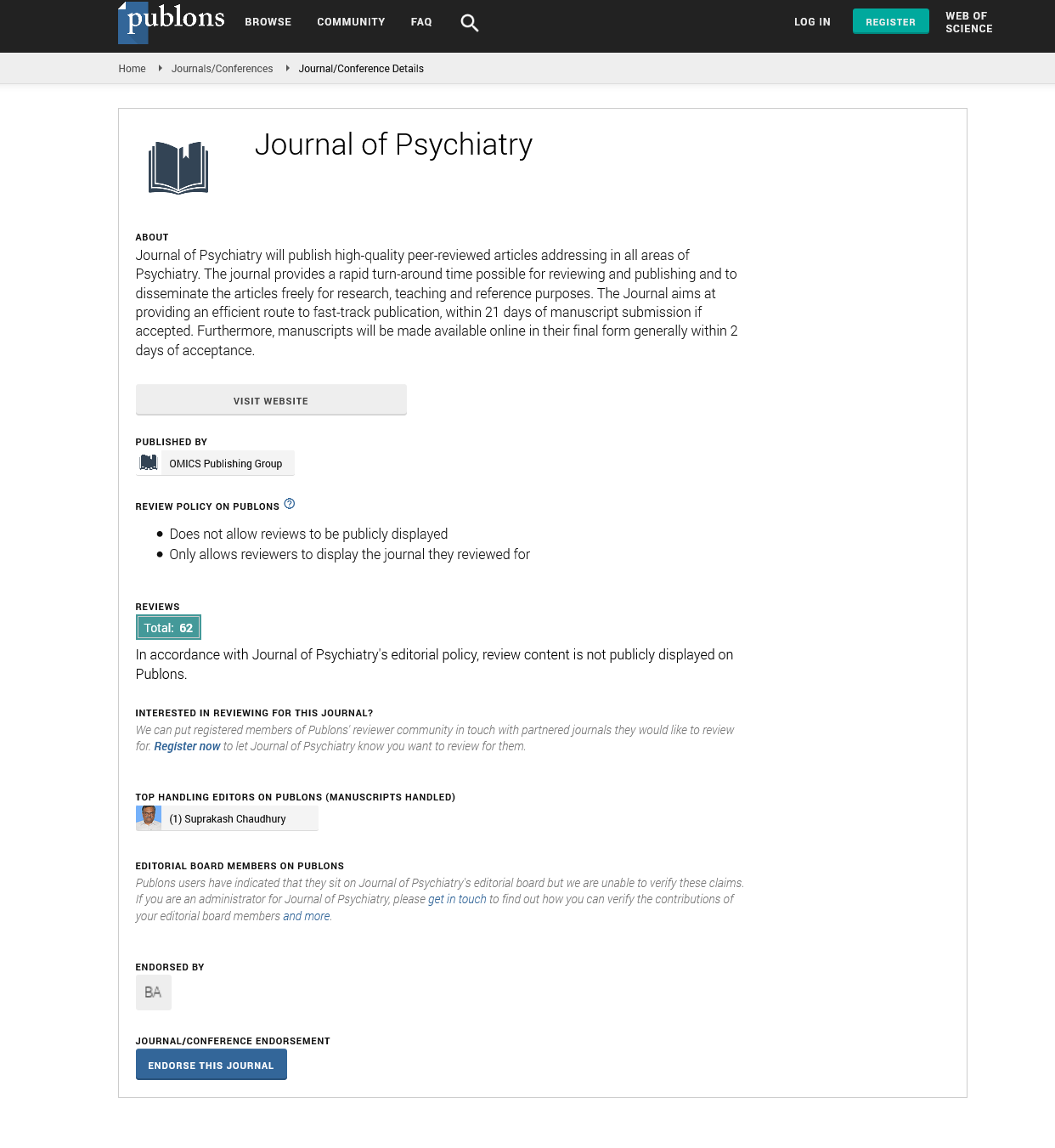Indexed In
- RefSeek
- Hamdard University
- EBSCO A-Z
- OCLC- WorldCat
- SWB online catalog
- Publons
- International committee of medical journals editors (ICMJE)
- Geneva Foundation for Medical Education and Research
Useful Links
Share This Page
Open Access Journals
- Agri and Aquaculture
- Biochemistry
- Bioinformatics & Systems Biology
- Business & Management
- Chemistry
- Clinical Sciences
- Engineering
- Food & Nutrition
- General Science
- Genetics & Molecular Biology
- Immunology & Microbiology
- Medical Sciences
- Neuroscience & Psychology
- Nursing & Health Care
- Pharmaceutical Sciences
Commentary - (2025) Volume 28, Issue 3
The Role of Early Life Stress in Adult Psychiatric Disorders
Thomas Fischer*Received: 01-May-2025 Editor assigned: 03-May-2025 Reviewed: 17-May-2025 Revised: 23-May-2025 Published: 31-May-2025, DOI: 10.35248/2378-5756.25.28.747
Description
Experiences during early childhood have a profound and lasting influence on mental health. Events that occur during critical developmental stages can shape how individuals manage stress, regulate emotions, interpret social cues and build meaningful relationships throughout their lives. Recent psychiatric research has increasingly focused on how Early Life Stress (ELS) contributes to the onset, severity and chronicity of various mental health conditions in adolescence and adulthood. Early life stress includes experiences such as neglect, physical or emotional abuse, parental separation, family conflict, poverty and exposure to violence. These Adverse Childhood Experiences (ACEs) are now widely recognized as having enduring psychological effects that shape both behavior and emotional functioning across the lifespan. Children who are exposed to repeated or intense stress may develop altered behavioral and emotional response patterns. For instance, growing up in environments that are unpredictable or threatening can lead to heightened vigilance, increased fear responses, or emotional withdrawal. Such adaptive responses, while protective in dangerous situations, can interfere with healthy social development. As a result, individuals may struggle with trust, intimacy, or forming secure attachments in later life. In clinical settings, adults with histories of early stress often present with challenges in emotional regulation, impulse control and interpersonal relationships, which can complicate diagnosis and treatment.
A key area of current research is how early stress affects brain development. Chronic exposure to elevated levels of stress hormones, especially cortisol, during childhood can disrupt the normal development and functioning of critical brain regions. For example, the amygdala, which is involved in detecting threat and processing fear, may become hyperactive or over-reactive. Similarly, the prefrontal cortex, which is responsible for executive functions like planning, decision-making and impulse control, may show delayed or altered development. The hippocampus, important for learning and memory, may also be reduced in volume in individuals with prolonged stress exposure. While these changes do not predetermine mental illness, they can increase vulnerability to developing conditions such as anxiety, depression and personality disorders, particularly when combined with genetic or environmental risks later in life. Early life stress also appears to influence the biological stress regulation system, particularly the Hypothalamic-Pituitary- Adrenal (HPA) axis. Many individuals who experienced childhood adversity exhibit signs of a dysregulated HPA axis, which can result in exaggerated or blunted physiological responses to stress. This may explain why some people seem to overreact to minor stressors, while others become emotionally numb or detached in challenging situations. The dysregulation of this system has long-term effects on emotional resilience and overall mental health. Consequently, researchers are exploring early intervention strategies that may recalibrate stress response systems before adulthood, potentially improving long-term mental health outcomes.
In conditions such as major depressive disorder, early life stress is often identified as a key contributing factor to both initial episodes and recurrent relapses. Individuals who have experienced ACEs may develop more persistent or treatmentresistant forms of depression. They may also respond differently to standard treatments, with some showing limited improvement from antidepressants alone. In such cases, trauma-informed therapies which directly address the impact of early experiences can be more effective. Recognizing the lasting influence of early adversity helps clinicians tailor treatment plans that address both present symptoms and past trauma. Substance use disorders are another area strongly linked to early life adversity. Individuals who experienced childhood neglect, abuse, or emotional deprivation may turn to substances as a coping mechanism to manage unresolved emotional pain or trauma. The connection between early trauma and later addiction is well-documented and treatment programs are increasingly adopting integrated approaches. Trauma-informed care, when combined with addiction support, tends to improve patient engagement, reduce relapse rates and foster long-term recovery by addressing the root causes of substance misuse.
Post-traumatic stress symptoms related to childhood events often persist well into adulthood, even in the absence of recent trauma. Adults with unresolved early trauma may experience flashbacks, intrusive memories, nightmares, or emotional numbness that interfere with daily functioning. These symptoms can impact work performance, relationship quality, self-esteem and even physical health. Addressing unresolved trauma through evidence-based treatments such as EMDR (Eye Movement Desensitization and Reprocessing) or trauma-focused cognitive behavioural therapy is often essential to reduce symptom severity and improve quality of life. Emerging research has also explored the link between early life stress and psychotic disorders, including schizophrenia. While these conditions are heavily influenced by genetics, studies suggest that exposure to childhood trauma may influence the timing, severity, or course of psychotic symptoms in genetically predisposed individuals. For example, early adversity may intensify hallucinations, delusional thinking, or cognitive disorganization. This has led to increased interest in early screening for emotional and behavioural difficulties in childhood as a way to identify individuals at risk and offer preventive care or early intervention.
Citation: Fischer T (2025). The Role of Early Life Stress in Adult Psychiatric Disorders. 28:747
Copyright: © 2025 Fischer T. This is an open-access article distributed under the terms of the Creative Commons Attribution License, which permits unrestricted use, distribution and reproduction in any medium, provided the original author and source are credited

